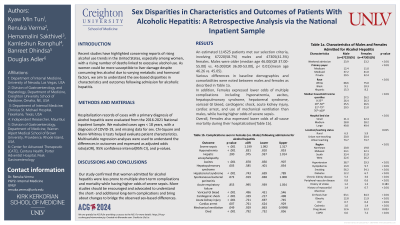Tuesday Poster Session
Category: Liver
P4618 - Sex Disparities in Characteristics and Outcomes of Patients With Alcoholic Hepatitis: A Retrospective Analysis via the National Inpatient Sample
Tuesday, October 29, 2024
10:30 AM - 4:00 PM ET
Location: Exhibit Hall E

Has Audio
- RV
Renuka Verma, MD
University of Nevada
Las Vegas, NV
Presenting Author(s)
Kyaw Min Tun, DO1, Renuka Verma, MD2, Hemamalini Sakthivel, MD3, Kamleshun Ramphul, MD4, Banreet Dhindsa, MD5, Douglas Adler, MD6
1Creighton University School of Medicine, Las Vegas, NV; 2University of Nevada, Las Vegas, NV; 3One Brooklyn Health-Interfaith Medical Center, New York, NY; 4Independent Researcher, Triolet, Pamplemousses, Mauritius; 5NYU Grossman School of Medicine, New York, NY; 6Center for Advanced Therapeutic (CATE), Centura Health, Porter Adventist Hospital, Peak Gastroenterology, Denver, CO
Introduction: Recent studies have highlighted concerning reports of rising alcohol use trends in the United States, especially among women, with a rising number of deaths linked to excessive alcohol use. As women could be more susceptible to liver damage despite consuming less alcohol due to varying metabolic and hormonal factors, we aim to understand the sex-based disparities in characteristics and outcomes following admission for alcoholic hepatitis.
Methods: Hospitalization records of cases with a primary diagnosis of alcohol hepatitis were evaluated from the 2016-2021 National Inpatient Sample. We excluded cases ages < 18 years, with a diagnosis of COVID-19, and missing data for sex. Chi-Square and Mann-Whitney U tests helped evaluate patient characteristics. Multivariable regression analyses were used to understand the differences in outcomes and expressed as adjusted odds ratio(aOR), 95% confidence interval(95% CI), and p-values.
Results: An estimated 114525 patients met our selection criteria, involving 67220(58.7%) males and 47305(41.3%) females. Males were older (median age 46.00(IQR 37.00-55.00) vs. 45.00(IQR 36.00-53.00), p< 0.01)(mean age 46.26 vs. 45.05). Various differences in baseline demographics and comorbidities were noted between males and females as described in Table 1a. In addition, Females expressed lower odds of multiple complications including hyponatremia, ascites, hepatopulmonary syndrome, hepatorenal syndrome, variceal GI bleed, cardiogenic shock, acute kidney injury, cardiac arrest, and use of mechanical ventilation than males, while having higher odds of severe sepsis. Overall, Females also expressed lower odds of all-cause mortality during their hospitalization(Table 1b).
Discussion: Our study confirmed that women admitted for alcohol hepatitis were less prone to multiple short-term complications and mortality while having higher odds of severe sepsis. More studies should be encouraged and advocated to understand the short- and additional long-term complications and bring about changes to bridge the observed sex-based differences.
Note: The table for this abstract can be viewed in the ePoster Gallery section of the ACG 2024 ePoster Site or in The American Journal of Gastroenterology's abstract supplement issue, both of which will be available starting October 27, 2024.
Disclosures:
Kyaw Min Tun, DO1, Renuka Verma, MD2, Hemamalini Sakthivel, MD3, Kamleshun Ramphul, MD4, Banreet Dhindsa, MD5, Douglas Adler, MD6. P4618 - Sex Disparities in Characteristics and Outcomes of Patients With Alcoholic Hepatitis: A Retrospective Analysis via the National Inpatient Sample, ACG 2024 Annual Scientific Meeting Abstracts. Philadelphia, PA: American College of Gastroenterology.
1Creighton University School of Medicine, Las Vegas, NV; 2University of Nevada, Las Vegas, NV; 3One Brooklyn Health-Interfaith Medical Center, New York, NY; 4Independent Researcher, Triolet, Pamplemousses, Mauritius; 5NYU Grossman School of Medicine, New York, NY; 6Center for Advanced Therapeutic (CATE), Centura Health, Porter Adventist Hospital, Peak Gastroenterology, Denver, CO
Introduction: Recent studies have highlighted concerning reports of rising alcohol use trends in the United States, especially among women, with a rising number of deaths linked to excessive alcohol use. As women could be more susceptible to liver damage despite consuming less alcohol due to varying metabolic and hormonal factors, we aim to understand the sex-based disparities in characteristics and outcomes following admission for alcoholic hepatitis.
Methods: Hospitalization records of cases with a primary diagnosis of alcohol hepatitis were evaluated from the 2016-2021 National Inpatient Sample. We excluded cases ages < 18 years, with a diagnosis of COVID-19, and missing data for sex. Chi-Square and Mann-Whitney U tests helped evaluate patient characteristics. Multivariable regression analyses were used to understand the differences in outcomes and expressed as adjusted odds ratio(aOR), 95% confidence interval(95% CI), and p-values.
Results: An estimated 114525 patients met our selection criteria, involving 67220(58.7%) males and 47305(41.3%) females. Males were older (median age 46.00(IQR 37.00-55.00) vs. 45.00(IQR 36.00-53.00), p< 0.01)(mean age 46.26 vs. 45.05). Various differences in baseline demographics and comorbidities were noted between males and females as described in Table 1a. In addition, Females expressed lower odds of multiple complications including hyponatremia, ascites, hepatopulmonary syndrome, hepatorenal syndrome, variceal GI bleed, cardiogenic shock, acute kidney injury, cardiac arrest, and use of mechanical ventilation than males, while having higher odds of severe sepsis. Overall, Females also expressed lower odds of all-cause mortality during their hospitalization(Table 1b).
Discussion: Our study confirmed that women admitted for alcohol hepatitis were less prone to multiple short-term complications and mortality while having higher odds of severe sepsis. More studies should be encouraged and advocated to understand the short- and additional long-term complications and bring about changes to bridge the observed sex-based differences.
Note: The table for this abstract can be viewed in the ePoster Gallery section of the ACG 2024 ePoster Site or in The American Journal of Gastroenterology's abstract supplement issue, both of which will be available starting October 27, 2024.
Disclosures:
Kyaw Min Tun indicated no relevant financial relationships.
Renuka Verma indicated no relevant financial relationships.
Hemamalini Sakthivel indicated no relevant financial relationships.
Kamleshun Ramphul indicated no relevant financial relationships.
Banreet Dhindsa indicated no relevant financial relationships.
Douglas Adler: Boston Scientific and Micro Tech. – Consultant.
Kyaw Min Tun, DO1, Renuka Verma, MD2, Hemamalini Sakthivel, MD3, Kamleshun Ramphul, MD4, Banreet Dhindsa, MD5, Douglas Adler, MD6. P4618 - Sex Disparities in Characteristics and Outcomes of Patients With Alcoholic Hepatitis: A Retrospective Analysis via the National Inpatient Sample, ACG 2024 Annual Scientific Meeting Abstracts. Philadelphia, PA: American College of Gastroenterology.
